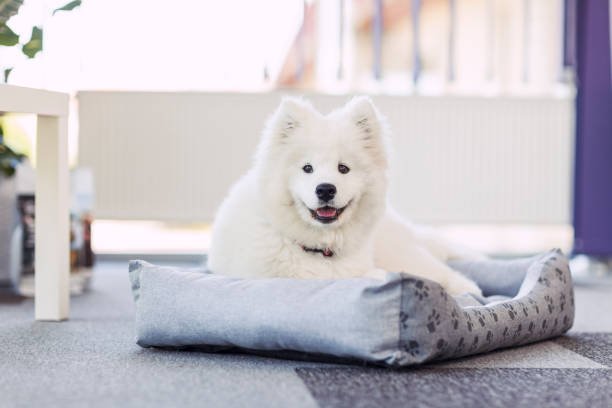Why get a Samoyed Puppy?
The large, white, fluffy dog with a huge grin on its face cannot be mistaken for any other breed. The Samoyed, sometimes known as a “Sammie,” is a breed of dog that is popular because to the affectionate and outgoing characteristics of its dogs as well as its abundant, white coats.
A Brief Overview of the Samoyed Breed’s History
The Samoyed is one of the oldest dog breeds that may be found anywhere in the globe. They got their name from a tribe known as the Samoyede who lived in Asia and Siberia.
The dogs were bred to aid hunters in tracking and killing reindeer, as well as to protect and herd the animals. They were also responsible for pulling sleds for the nomadic tribes.
Another one of the Samoyed’s key jobs was to keep their human companions warm by snuggling up to them when they slept in their tents during the very cold nights. This was done in an effort to ward off the freezing conditions.
The Samoyed breed was introduced to England in the 1800s, and Queen Alexandria, who had been given a Samoyed as a gift, was instrumental in advancing the breed’s reputation.
In 1906, the same year that they initially came in the United States, they were given official recognition by the American Kennel Club. In the 1900s, they gained popularity as a sledding dog as well as a pet, and they continue to serve in both capacities even now.
Characteristics of the Samoyed’s Physical Appearance
The average Samoyed weighs between 50 and 60 pounds and is considered a medium-sized dog. They are a breed of spitz and have the typical “look” of these dogs, which includes upright, triangular ears, a nose that is of medium size, a fluffy plumed tail, and a compact, athletic body.
In contrast to their white fur, their eyes, nose, and lips are entirely black, giving them a striking appearance. They are recognized for their kind, intellectual demeanor, which gives them the nickname “Samoyed grin.”
Samoyeds, their Coats, and their Shedding
The beautiful white double coat that Samoyeds have is perhaps the breed’s most defining characteristic. Their coats are robust and intended to protect them from the harshest environments. While the undercoat is fluffy and wooly, the outermost layer is straight and harsh.
Although white is the hue that is most often associated with the Samoyed, they may also come in the colors biscuit or cream, or even a combination of white and biscuit.
It is necessary to brush this breed of dog at least once a day in order to keep their coat in good condition, prevent mats from forming, and keep the excessive shedding under control.
The Samoyed is not the best choice for you if you like your home to be free of dog hair. On the other hand, they are a breed that is noted for not having a lot of odor, so that is positive to the impact that their high shedding is going to have on your house.
Samoyed Character and Temperament
The Samoyed is a fantastic canine companion and an outstanding choice for a family pet. They are kind and kind to everyone they encounter, and despite their height and power, they can be patient and kind to younger children.
The Samoyed, much like other Northern breeds of dogs, can be rather “talkative” and may howl, whine, and bark to let you know what’s going through his mind.
They are also capable of becoming destructive if they are allowed to get bored and are not provided enough to do. They get along well with other canines, but since they have a strong urge to hunt, it’s best to avoid bringing them into a household that also has cats and other small pets.
Requirements for Physical Activity in a Samoyed
Due to the fact that the Samoyed was bred to be a working dog, they need a respectable amount of daily activity to prevent them from becoming destructive.
Joggers, runners, hikers, and persons who like participating in winter activities with their dogs, such as skijoring, are all suitable candidates for wearing them.
However, if you live in a warmer region, you may need to adjust the amount of time that you spend exercising your dog each day to account for the weather since dogs with thick coats are at risk of overheating if they exercise too much.
Teaching a Samoyed some tricks
The Samoyed is a very clever breed of dog that must be trained with positive reinforcement and persistence in order to be successful.
This is a dog that has been developed to think for himself and requires an owner who is able to keep up with him. Despite the fact that they may be labeled as being obstinate, this is merely a fact about the breed.
They are a fantastic option for competitive dog obedience and other dog sports activities like agility. Their patient, kind demeanors also make them excellent candidates for employment as therapy dogs.
Health Concerns Relating to the Samoyed
The lifetime of a Samoyed typically ranges from ten to twelve years on average. Although the Samoyed is generally considered to be a healthy breed of dog, there are a few health issues that are more prevalent in the breed. The following are some of these:
- If diabetes is not managed, it may cause blindness and ultimately lead to death.
- If quick medical attention is not sought, gastric torsion, sometimes referred to as bloat, is a twisting of the stomach that may be deadly.
- Glaucoma is a condition in which there is a hazardous rise in pressure inside the eye, which may lead to visual loss.
- Diseases of the heart might include congenital cardiac abnormalities, dilated cardiomyopathy, and heart murmurs.
- Hip and elbow dysplasia is an excruciating disorder of the skeletal system that may ultimately result in lameness.
- Hypothyroidism is a condition that affects a dog’s endocrine system and may cause the dog to gain weight, as well as have skin and a coat that are unattractive.
- A luxating patella is a disease of the kneecap that has to be surgically corrected.
- The dog will eventually become blind as a result of progressive retinal atrophy, which causes the retina to degenerate.
- This disorder is known as Samoyed Hereditary Glomerulopathy, and it causes inflammation in the kidneys. If left untreated, it may result in kidney failure.
Obtaining a Samoyed Dog Puppie
The Samoyed Club of America is the ideal way to begin your search for a Samoyed puppy that is of the pure breed. Their website has both a directory of breeders and groups to choose from.
The SCA advises people who are considering getting a dog that they should make sure the breeders they get it from screen their pets for diseases that are typically present in the eyes, hips, and hearts of dogs. You should budget somewhere between $675 and $1,500 for a purebred puppy.
The saving of a Samoyed
If you are interested in rescuing a Samoyed, the website of the Samoyed Club of America (SCA) has a directory of Samoyed rescue organizations located all across the United States.
You may also use websites such as Petfinder and Adopt-a-Pet to look for Samoyeds at public shelters and rescue groups that take in animals of all breeds.
In light of the fact that Samoyeds have certain exercise requirements and a grooming routine, it is important to ensure that you are ready to take in an adult Samoyed before rescuing one.
Is a Samoyed the Right Breed of Dog for You to Get?
The “Smiling Sammie” is a great dog that would make an excellent companion for almost anybody who is able to provide it the kind of home environment it requires.
Even though they are loving, affectionate, and very clever dogs, they still need a frequent activity that goes beyond just taking a stroll around the block once a day. In addition to this, they need positive and regular training as well as a daily grooming regimen that is committed to.
However, if you lead a more sedentary lifestyle and don’t have the time to take care of all of their daily demands, it may be too much work for you to take on the responsibility of owning one of these dogs.
Symptoms And Allergies From Dog Food
How To Determine A Puppy’s Full Growth
Why Do Dogs Sunbathe? 5 Major Health Advantages
Home Treatments For Itchy Paws In Dogs
3 Recipes For Christmas Dog Treats To Celebrate The Holidays
Which Airlines Are The Safest For Traveling With Pets?




